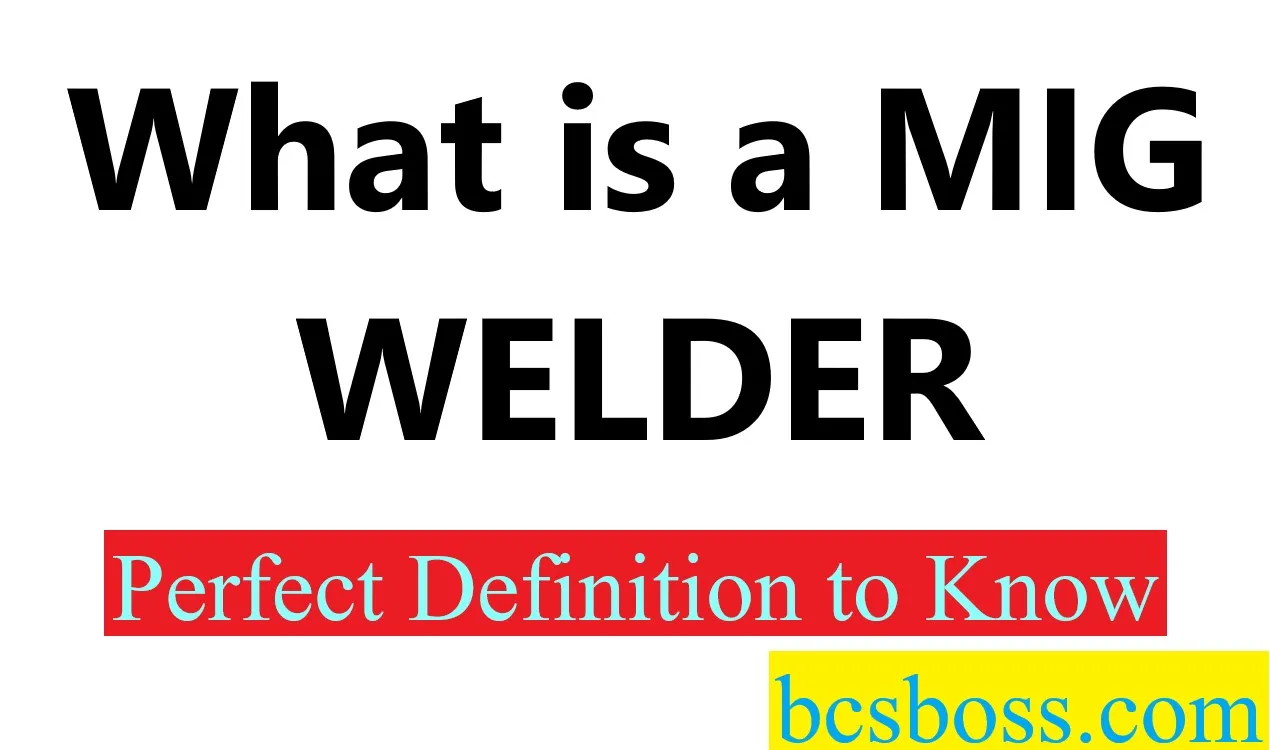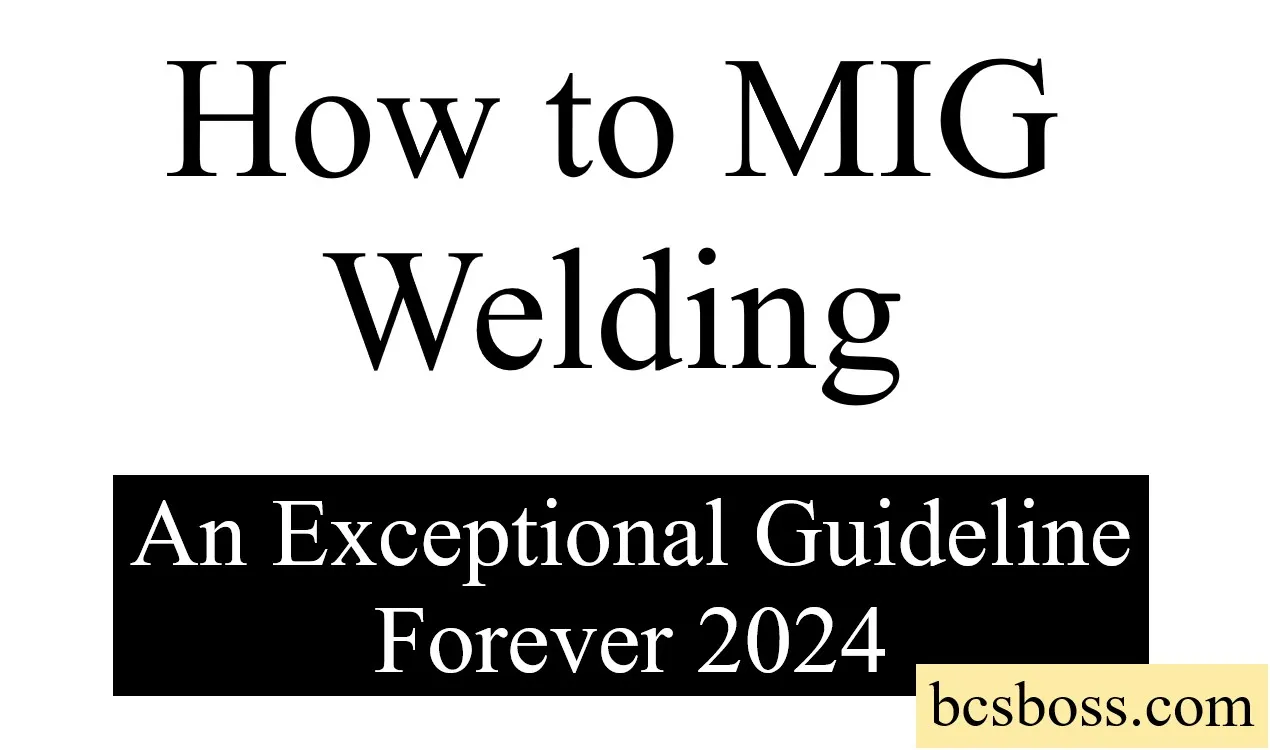MIG stands for Metal Inert Gas. MIG welding is a pronounced way to add specialized traces to your DIY developments. The process is GMAW (Gas Metal Curve Welding), usually recognized as MIG welding (Metal Inert Gas welding).
It was industrialized at the time of World War II as a fast, moveable procedure to generate durable, strong joints. Nowadays it is used in numerous workshop and industrial unit applications plus by home hobbyists and welding fans. In this guide you are here to know about What is a MIG WELDER and Perfect Definition to Know in 2024.

Perfect Definition of MIG WELDER in 2024
MIG welding has many useful uses, from automobile work to home reparation. Welding procedure is an electrical curve formed amongst an expendable cable conductor and the workpiece metal, which temperatures the workpiece metal, affecting them to liquefy and joint is called welding.
If you are thinking about getting involved in welding, you have to find out what kind of welding you are interested in. Before purchasing any gear, you should find out this. Most welding gears are skilled constructing maximum joins in metal, but they are all better at some works than others are. By far the worldwide welder is a MIG.
Top 10 Reviewed Rangefinder in 2024: Top 10 Reviewed Rangefinder in 2024 | Most are Budget-Friendly
You can practice a MIG welder to weld thin measurement sheet metal or weighty steel tube. A professional can create lovely, level, profound welds by a MIG welder, but an unprofessional can get an acceptable weld out of the machine, too.
MIG welding procedures a device to feed a cable over a contact tip hooked on a MIG gun. The electrically charged interaction tip transmits the welding current to the cable. The curves established amongst the cable and the base metal. Frequently an inert gas is used, which tides out of the gas needle to protect the welding procedure from the environment.
There are some modes of metal transfer:
- The Short Circuit (Which is used for skinny/thin metals)
- The Globular Transfer (Which is used for weightier/heavier metals)
- The Spray Transfer (The hottest mode)
When you absorb how to use a MIG welder, you can take care of the home. A MIG welder also can be used against stainless steel, mild steel, and aluminum of all sizes & thicknesses. Protecting gasses will differ depending on base metal and welding cable. You will need a full set of protective gear to make sure your protection while welding. This includes clothing, protective, gloves, and masks.
Difference Between MIG Welding vs TIG Welding: Trending Difference Between MIG Welding vs TIG Welding 2024
Know the Safety:
You should follow the steps below for your safety:
- Ensure that all of your body is covered to avoid overexposure from UV heats. You must require a darker mask. This will help to avoid curved eyes.
- If you are working under the circumstances of the less ventilated zone, you should wear a smoke mask to reduce the quantity, which deadly vapors breathe in while the welding procedure.
- Wear hand gloves that can defend your skin from melted metal.
- Preserve Extinguisher, which contains CO2 and a container of sand adjacent to disaster fires.
There are also some steps, which should be followed if you want to learn well about MIG Welding.
Notable Power Tools: Notable Power Tools for Advanced Wood Workers 2024
They are:
Select a MIG gun to use at ease.
Some are formed like pistols; however, others may look like acetylene torches. The dimension of the device will be contingent on the dimension of the project.
A MIG gun might also be air or liquid cooled. Air-cooled guns use less or up to200 amps and are easier to influence in minor ranges. The air-cooled gun is the kind that home-based MIG welder normally use.
Organize the welding zone:
Eliminate all inflammable material and discover a good external to weld. Though you can put the ground link right on the portion you are welding, maximum workshops have a big metal work table that the ground is bent.
If there are other persons existing, set up welding swags around the work zone. This will defend them from UV light damage.
Get the accurate cable:
Use the similar cable type as the material you are welding. Suppose, you are welding on a stainless steel sheet, so you should use stainless steel cable for this task.
For steel welding, AWS ER70S-3 is a cable, which can be used for all purposes. This is generally the most efficient choice. Another one is AWS ER70S-6. This is a first-class steel cable. It Was Designed for welding on unhabituated or muddy steel. E71TGX another classified cable, which requires no protecting gas. It is appropriate for welding in great winds and for rusty or muddy resources.
The Width of your cable varies based on the fatness of the metal you are welding. Everyone should weld thin metals with thin cables and thicker metals by thicker cable. You might require a bigger device for thicker metals.
Best Foosball Player in the World: Hidden about 3 Best Foosball Player in the World
Always organize the reel:
Tighten up the pressure on the reel so that the cable does not loosen due to its own pressure. Make the primary 3 inches (7.6 cm) of the cable as straightforward as possible to evade masses or loss to the line feeder. Use a cable cutter to trim the cable perfectly.
Always feed the cable to the torch:
Insert the cable into the conductor pipe and feed it to the roller. Insert it into the cable inside the layer. If you have to use strength, probabilities are that the cable is not aligned accurately.
Ensure the cable is free from oxidation or lubricant. This will ground bad welds. Use a waterless fabric to clean any muddy cable earlier inserting it. Cable will become oxidized if left in the welder when not in use. Once the cable is inserted into the liner, turn the welder on and use the cable feed device to drive the cable over the welder.
Make sure to adjust the pressure:
After finishing Your cable feeding, you will need to correct the pressure. Too much pressure will reason the mountings to curve, destructive the welder. Keep the pressure at the smallest amount that still lets the link to be fed. Be sure to check the pressure on the roll besides on the line feeder. Both must be as low as possible.
Set the MIG welder device polarization to DCEP:
This is the opposite polarity.
Keep a reliable conductor distance:
Think, you are welding; keep your conductor prolonged amongst ¼” and 3/8” from the contact pipe. This will help make a fresh, systematic weld.
Use the appropriate defensive gas:
Use carbon dioxide as an inexpensive choice to deliver more profound saturation on steel. This will also be hot for thin metals. Use argon for aluminum welding, and a mix of 75% argon and 25% carbon dioxide for thinner steel.
Joining by push or drag welding method:
The position should not go above 10 degrees in both methods. Keep the cable at the front edge of your weld puddle. This will give you better control over your weld. Drag welding jerks the bead alongside with the top. This will give you a more profound saturation and a thinner bead.
Push welding shoves the bead with the top. This will give you a broader bead.
Build a smooth weld:
Always use the welder to place material straight hooked on the joints. You can use a rear and forward technique to fill large gaps. For smooth joints, grip the gun at an angle of 90°.
Create a perfect horizontal weld:
You must lower the gun approach a little to preserve the filler from drooping. Keep the same shove or jerk angle as normal. Use a back-and-forth weave motion to fill large gaps. Keep the amperage similar to a smooth weld. You may need to use a little smaller width to keep the weld puddle from receiving excessively big.
Create a perfect vertical weld:
For thin materials, begin at the topmost and move the puddle down with gravity. This keeps the arc from piercing the material. For thicker metals, begin at the baseline and work up. This will greatly support growth the penetration. You may want to lessen the amperage by approximately 10% -15% to assist combat with the gravity.
Try to do overhead welding:
By using average welding methods, but grow your transportable swiftness. This will help stop plaster from falling out of the joints. You might need to increase your air movement rate.
Keep your needle fresh, as spatter will shape up quicker once welding overhead.
Finishing the welding process:
After you end up with the weld procedure, break off all the extra filler. If the MIG welder is faulty, break it down and do a re-welding on the joints.






